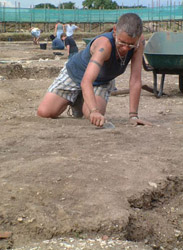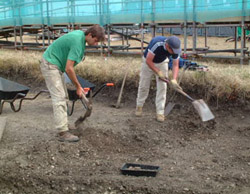| The 2001 Season Week 1 by Amanda Clarke |
| Day 1: 9th July 80 participants are treated to a day of introductory lectures including ‘housekeeping’ talks by the cook, the site manager and the administrative assistant. Health and Safety talks and site tour were followed by assignment to supervisors and instruction on use of tools, site and finds etiquette. During the afternoon, site cleaning commenced. |
 |
|
Day 3: 11th July All trainees received training on site recording methods, both written and drawn and work on site continued in the afternoon. An interesting find from today was a fragment of a quern stone of Old Red Sandstone, from the Forest of Dean. This had been reused in the make up of a floor surface associated with Building 8. |
 |
|
Day 4: 12th July Todays training covered the use of photography on site and information about the project database, the IADB (Integrated Archaeological database). Work continued on site in the afternoon
|
|
Day 6: 14th July Work continued on site with trainees cleaning, excavating and planning the features they were working on. For some it was the last day of their participation and we said goodbye to them in the afternoon. Additional training was offered today on the intricacies of small finds drawing and on digital reconstruction of some of the buildings of House 1. An interesting small find today was a fragment of an arm of a possible figurine
|
|
Day 7: 15th July Work begins on deposits pre-dating Buildings 1, 5 and 7 in the south-east corner of the site and in the southern most part of the area where we are still working with deposits external to and contemporary with Building 1. Deposits immediately below Building 1 are suggestive of floors to be associated with an earlier building. The walls for this building elude us, although a linear clay-filled feature running north-east / south-west may be a wall footing. Removal of the build up of soils beneath Buildings 5 and 7 are revealing intercut pits apparently cut into a yellow clay similar to the construction level of the latest phase of House 1. More post holes associated with Buildings 7 and 9 are appearing parallel to the north south road. We also have evidence for an earlier building which may be running underneath the latest road surface: a linear footing and associated flints.
|
|
Silchester
Home | Archaeology
Home | Reading
Home © 2002 Reading University Archaeology Department.
|